

 |
some calculations in plane geometry |  |
 |
This article describes some formula's in plane geometry.
They are nice applications of algebra.
List of contents:
- the area of a triangle
- the projection formula
- Stewart's formula
- the length of the median
- the bisector formula
- the radius of the circumscribing circle
- the radius of the inscribed circle
- the radius of the escribed circle
- kissing circles
- intersecting circles
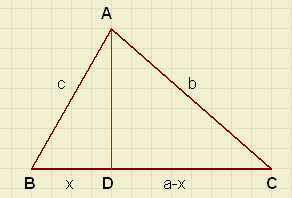
|
but not the height, a formula for the area of the triangle without
this height would be of help.
Please look at the picture right:
the base, opposite angle A, has length a.
BD = x, so DC = a - x. AD = h.
Side b is opposite angle B, side c is opposite angle C.
There we go:
application of the theorem of Pythagoras in triangles ABD and ADC
results in two equations:
| | | c 2 = h 2 + x 2 b 2 = h 2 + (a − x) 2 |
| |
| | | h 2 = c 2 − x 2 h 2 = b 2 − (a − x) 2 |
| |
-
c 2 − x 2 = b 2 − (a − x) 2
-
c 2 − x 2 = b 2 − (a 2 − 2 a x + x 2)
-
c 2 − x 2 = b 2 − a 2 + 2 a x − x 2
-
c 2 = b 2 − a 2 + 2 a x
-
2 a x = a 2 − b 2 + c 2
-
x =
| a 2 − b 2 + c 2 |
| 2 a |
-
h 2 =
| æ | c −
| ö | | |
| è | ø |
| æ | c +
| ö | | |
| è | ø |
-
h 2 =
| 2 a c − a 2 + b 2 − c 2 |
| 2 a |
| 2 a c + a 2 − b 2 + c 2 |
| 2 a |
-
h 2 =
| −(a 2 − 2 a c + c 2 − b 2) |
| 2 a |
| a 2 + 2 a c + c 2 − b 2 |
| 2 a |
-
h 2 =
| −((a − c) 2 − b 2) |
| 2 a |
| (a + c) 2 − b 2 |
| 2 a |
-
h 2 =
| b 2 − (a − c) 2 |
| 2 a |
| (a + c) 2 − b 2 |
| 2 a |
-
h 2 =
| (b − a + c) (b + a − c) |
| 2 a |
| (a + c − b) (a + c + b) |
| 2 a |
-
h 2 =
| (−a + b + c) (a + b − c) (a − b + c) (a + b + c) |
| 4 a 2 |
If s is half of the circumference, than
-
( a + b + c) = 2s
(-a + b + c) = 2s - 2a
( a + b - c) = 2s - 2c
( a - b + c) = 2s - 2b
and the formula changes to
-
h 2 =
| 2 s (2 s − 2 a) (2 s − 2 b) (2 s − 2 c) |
| 4 a 2 |
-
h 2 =
| 4 |
| a 2 |
-
h =
| 2 |
| a |
| \ | s (s − a) (s − b) (s − c) |
| a h |
| 2 |
-
A =
| \ | s (s − a) (s − b) (s − c) |
are known (but not the height).
An Example
A triangle has sides of length 7, 8 and 11.
So, s = (7 + 8 + 11) / 2 = 13.
The area O =
| \ | 13 (13 − 7) (13 − 8) (13 − 11) |

the projection formula
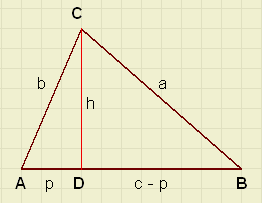
|
-
a2 = h2 + (c - p)2
a2 = b2 - p2 + c2 - 2cp + p2
a2 = b2 + c2 - 2cp
| a2 = b2 + c2 - 2cp |
remark: If point D is right of B, -2cp changes into +2cp.
The reader may verify this.
p is the projection of b to c. hence the name.
Stewart's formula
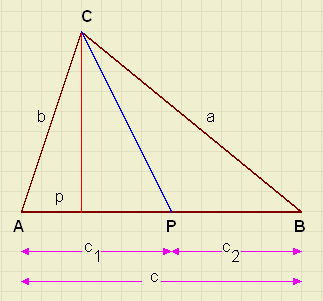
|
P divides AB in lines c1 and c2.
The formula of Stewart calculates the length of CP, if the sides a,b,c
of the triangle and the position of P are kwown.
Application of the projection formula in triangles APC and ABC :
| | | C P 2 = b 2 + c1 2 − 2 c1 p a 2 = b 2 + c 2 − 2 c p |
| |
| | | c C P 2 = b 2 c + c c1 2 − 2 c c1 p c1 a 2 = b 2 c1 + c1 c 2 − 2 c c1 p |
| |
-
c C P 2 − c1 a 2 = b 2 c − b 2 c1 + c c1 2 − c1 c 2
-
c C P 2 = c1 a 2 + b 2 c − b 2 c1 + c c1 2 − c1 c 2
-
c C P 2 = c1 a 2 + b 2 (c1 + c2) − b 2 c1 + c c1 2 − c1 c 2
-
c C P 2 = c1 a 2 + c2 b 2 + c c1 (c1 − c)
-
c C P 2 = c1 a 2 + c2 b 2 + c c1 (c1 − c1 − c2)
-
c C P 2 = c1 a 2 + c2 b 2 − c c1 c2
| c.CP2 = c1a2 + c2b2 - 2c.c1.c2 |
the length of the median
If AP = PB then CP is the median of angle C.
For c1 = c2 and CP = Zc Stewart's formula changes into:
-
c Zc 2 =
| c |
| 2 |
| c |
| 2 |
| c |
| 2 |
| c |
| 2 |
-
Zc 2 =
| a 2 |
| 2 |
| b 2 |
| 2 |
| c 2 |
| 4 |
Zc 2 =
|

the bisector formula
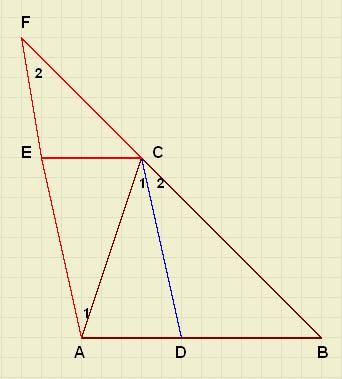
|
First a theorem of plane geometry to get a relation
between a,b and c1,c2.
Given:
-
DABC
CD divides LC.
-
In a triangle, the bisector divides the opposite side in parts with
the same ratio as the sides of the angle:
-
AD : DB = AC : BC
-
make BC longer
draw AF || CD and
EC || AB
because of parallellism of lines:
-
LC1 = LA1
LC2 = LF
-
LF = LA1
in a triangle, sides opposite equal angles are also equal, so
AC = FC
-
EC : DB = FC : BC
-
EC = AD
-
AD : DB = FC : BC
-
AD : DB = AC : BC
Starting with
| a |
| b |
| c2 |
| c1 |
-
ac1 = bc2
-
c C P 2 = c1 a 2 + c2 b 2 − c c1 c2
-
c C P 2 = a b c2 + a b c1 − c c1 c2
-
c C P 2 = a b (c1 + c2) − c c1 c2
-
C P 2 = a b − c1 c2
| C P 2 = a b − c1 c2 |
| | | a c1 = b c2 c1 = c − c2 |
| |
-
c1 =
| b c |
| a + b |
c2 =
| a c |
| a + b |
-
C P 2 =
| 4 a b |
| (a + b) 2 |
Calculations are left to the reader.

the radius of a circumscribing circle
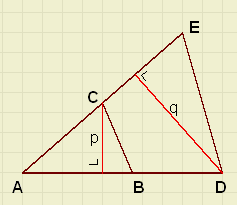
|
-
If two triangles have a common angle, then the ratio of their areas is equal to
the ratio of the products of their sides forming the angle.
-
area.DABC : area.DADC = (p.AB) : (p.AD) = AB : AD
area.DADC : area.DADE = (q.AC) : (q.AE) = AC : AE
-
AB : AD = (AB.AC) : (AD.AC)
AC : AE = (AD.AC) : (AD.AE)
-
area.DABC : area.DADE = (AB.AC) : (AD.AE)
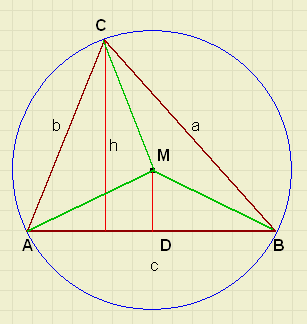
|
the circumscribing circle of DABC.
applying the theorem of Thales:
-
LDMB = 0.5*LAMB = LC
-
area DABC : area DDMB = (AC.BC) : (DM.BM)
-
area DABC : area DDMB =
(
| c |
| 2 |
| c |
| 4 |
-
BM = R {the radius}
AC = b
BC = a
AB = c
| = |
|
-
R =
| a b |
| 2 h |
-
h = 2*area DABC / c and
R =
|

the radius of inscribed circle
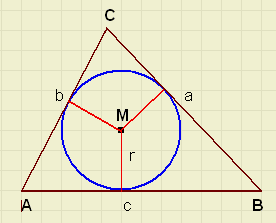
|
-
2 * area DABC = ar + br + cr = r(a + b + c)
r =
|
the radius of the escribed circle
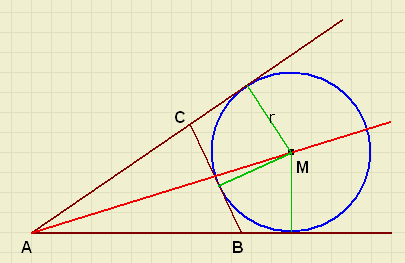
|
ra =
|
-
BC = a
AC = b
AB = c
(a + b + c) / 2 = s
Suggested exercises:
r, ra , rb , rc are the radius of the in- and escribes circles of DABC.
A is the area of DABC.
prove that:
1. A =
| \ | r ra rb rc |
2.
| 1 |
| r |
| 1 |
| ra |
| 1 |
| rb |
| 1 |
| rc |

kissing circles
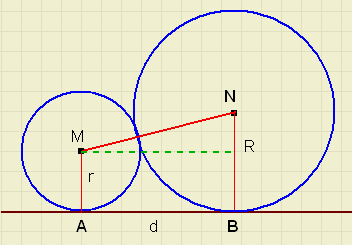
|
We derive a formula for the distance d = AB.
Application of the theorem of Pythagoras:
-
(R + r)2 = d2 + (R - r)2
R2 + 2Rr + r2 = d2 + R2 - 2Rr + r2
d = 2
|
In the picture above, a small circle with radius x just fits between the
line and the circles with radius r and R.
3. using the derived formula for d, prove that
| = |
|
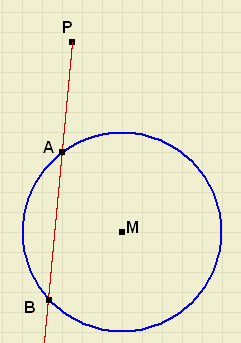
|
P is a fixed point.
A and B are randomly choosen points on the circle.
Prove, that PA.PB is a constant value.
(called: the power of P relative to the circle)
intersecting circles
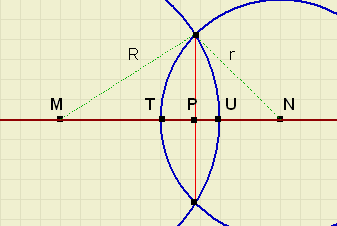
|
See picture right.
We derive a formula for the length of MP.
The picture shows
-
MT = d - r
NU = d - R
Now
-
R2 - MP2 = r2 - NP2 or
MP2 - NP2 = R2 - r2
(MP + NP)(MP - NP) = (d)(MQ + QP - (QN - QP)) = 2d.QP
-
2d.QP = R2 - r2
Q P =
| R 2 − r 2 |
| 2 d |
M P = M Q + Q P =
| d |
| 2 |
M P =
|

Suggested exercise:
see picture above.
5. find also formula's for NP, TP, UP.

